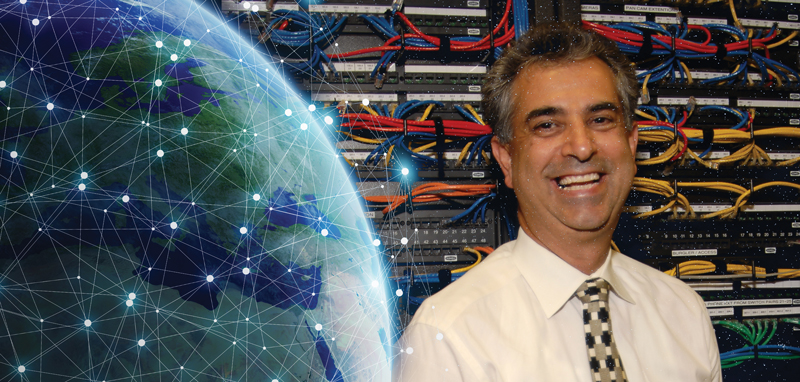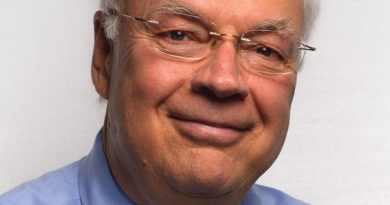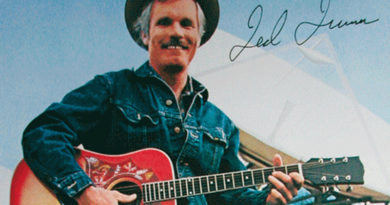Cable’s Modem Man Looks Back. And Ahead.
Interview by Stewart Schley
Legendary tech inventor Rouzbeh Yassini revisits his pioneering work in cable modem technology — and explains why broadband is still just a baby
More than 30 years ago Rouzbeh Yassini, the CEO of a then-unheralded tech company named LANcity, began leading a 13-person team that worked tirelessly to develop the first-ever cable modem. Their pioneering invention would lead to cable’s historic DOCSIS specifications and would ultimately usher in the modern global broadband era. Today, Yassini is Executive Director for the University of New Hampshire’s Broadband Center of Excellence. And as he explains in this exclusive Broadband Library interview, his work isn’t finished yet.
It’s such a time-warp to talk about your work in developing the cable modem. With apologies to the Beatles, it was 30 years ago today…
To be frank, it seems like a really short 30 years. Because our world today is totally different than it was during the industrial age, which started in the late 1700s. The industrial economy was based on a structure where consumers waited on producers to provide goods through a middleman at a store or a bazaar or a local market. In the 30 years since our work on the modem, the whole industrial age premise has almost vanished. Now, for the first time, you and I can be at our home acting as producers at the same time we’re consumers. We’re truly in the information age. We might call it the ‘Internet,’ but really it’s more. It has come to be a set of services that runs over a vast array of networks that brings the concepts of anything, anywhere and anytime together. We’ve redefined everything from news and information to health care, to commerce, and much more. It’s almost like a movie where magically you snap your fingers and things happen that are beyond imagination.
What was the role of the cable modem?
None of this would have happened without the invention of the cable modem and the success we had in bringing it to scale. Thirty years ago when we started at LANcity, the cost of a cable modem was about $18,000, and it literally took us a day to make one. Over time, scale became the enabling factor as the barrier of cost went away around the materials. So fifteen years later the wholesale price of a modem was less than $25 per unit. No other consumer electronics device has seen that kind of price drop, that fast, ever.
You make it sound like it was easy.
Anything but easy. We literally worked 24×7. We were peeling the onion so fast. And there was pessimism everywhere. When we were trying to make two modems a day, people would say to us, ‘I bet you can’t make four.’ When we got to four a day and were delivering those, the guys would say ‘I bet you can’t make sixteen.’ When we finally got to quantity, people would say, ‘I bet you can’t bring the price down.’ We were so beat up
But the vision was enough to keep your team going?
Well, we knew we were onto something big. My simple question was to find a solution for cable delivering data over one single wire; not two separate wires. I had a 13-person team, and we kept asking, ‘Do you believe data over cable can be as powerful as video over cable?’ Critics kept saying it couldn’t be done. Or at least it couldn’t be done affordably. But we kept peeling the onion.
When did you sense that people started buying in to the idea?
This is a story I have never told anybody: There was a company, a modem manufacturer, called U.S. Robotics. In 1996, the U.S. Robotics guys had a 28.8 (kilobits per second) modem. All of a sudden, they were excited to buy us. So we asked ourselves: ‘Why? Why would they want to buy us? What do you know about cable? You’re the phone modem people.’ They said, ‘Don’t worry about that; that’s our business.’ I still today believe the only goal they had was to buy us and kill us.
And obviously that was a deal you declined.
We did not sell to them. We were a privately held company and we were able to maintain our technology; to allow the baby to be born and to kick. The point is: There was a lot of naysaying. A lot of people didn’t want this technology to emerge. Remember that the phone companies at that time had T3 connectivity, but T3 cost $80,000 for a one-day or two-day rental. They were not about to reduce that price. We in the cable industry broke their back by being competitive and by creating 10 megabit per second connections and then 100 megabit connections. That’s when those guys started to bring the walls down and to bring new technology to the market. They had access to DSL, they had access to T1 and T3, but the question was, why should they bring the price down?
It’s ironic that sometimes cable doesn’t get credit for ushering in the broadband revolution.
I think the cable industry didn’t get credit for three things. First, we didn’t get credit for bringing broadband to the market — and we still don’t. We really haven’t marketed the word ‘broadband’ as a cable innovation. Second, we didn’t get credit for doing this with the persona of entrepreneurs versus established, giant companies. And lastly, for making it nearly ubiquitous; for making this technology available and continuously improved with faster speeds and better performance. For making the revolution an evolution. We were bad at marketing and public relations. We were good at delivering services and solutions and making a lot of innovation happen.
What would you do different if you had a chance to do it all over?
The only regret I had is that amid the speed with which we brought the cable modem to the market — with three generations of technology in five years — I wish we would have had a way to capture $1 per modem in a royalty fund that we’d put back into the hands of the research and university community to keep the dream alive; to keep that speed of innovation going. Unfortunately, we don’t have that funding today, and I think we never adequately rewarded the original recipe for innovation.
Which was what?
Which was allowing engineers to do what they love to do: solve real problems. Engineers are not what everybody expects. They don’t sit in a vacuum. They peel back the layers. They identify a problem, they try to define whether a problem is solvable, and if so, what’s the best way to solve it. If you give them a good problem and an opportunity, if you align the mechanics to where they can see the problem faster, they can solve it that much faster. I saw a problem of wanting to put video and voice and data signals over the same cable. So we did that.
So…what’s missing?
Sometimes identifying the right problem is the biggest issue we have. That’s where the university and academic community can help to play a role. Innovators can come together under the umbrella of a research organization like the National Science Foundation or DARPA to create a broadband era of funding, just like DARPA and NSF have done. If we do that, nothing can stop this country from being the world leader for innovation in this area. So, my objectives for the Broadband Center of Excellence include getting affordable broadband to all, regardless of their economic status, and to more universally use broadband to provide connectivity for new and advanced services, including medical technologies for our aging population.
So your view is that broadband is still in its infancy?
My view is we still have a baby. And it still has a lot of growing up to do. My vision has always been: We need a broadband community. What do I mean? Here’s one example. This century is the first century where people will live to be well over 100 years old. This year well over 25 percent of our population is over 60. This is the population that tends to be overlooked by industry. The view is they’re retired, they’re going to go move to Florida or Arizona and sit and smoke cigars or play golf. No. This generation has adapted to broadband technology and access to the world’s knowledge. This generation knows the power of broadband connectivity. What we haven’t created for them is a quality of life. What if an elderly population wants to stay in the same community they have? Same city, town, people. Because now they have global access to a lot of resources. But are we giving them access in the right way to these resources and services and the sense of ownership and community that matches the enormous economic power they possess? To me, this is a focal point where broadband can innovate and enable, but we haven’t done it yet.
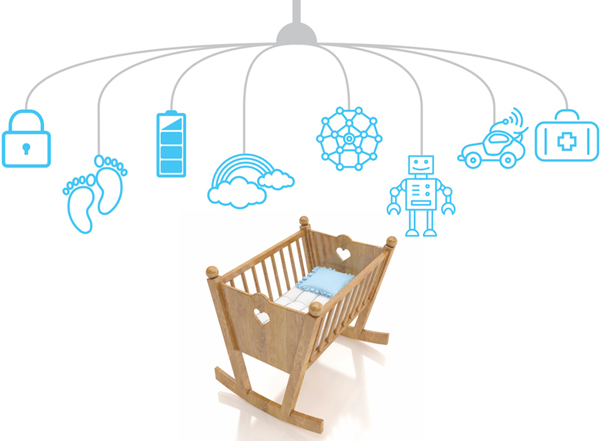
You published a book in 2003, Planet Broadband. What was the purpose?
Planet Broadband is a living, breathing, functioning roadmap. It describes a three-phase progression. First, physical connectivity. Done. Applications? Yes. But have we created a broadband community, where quality of life is elevated and where anybody can be a productive member of society throughout the entirety of their life? Where we sustain our planet while creating an economy that grows 10-fold? Where every individual is truly a global citizen? Not yet.
What’s your view of the link between broadband and economic progress?
Take an example from history. Look at where Eisenhower built the interstate highway system. A certain town, a certain county located where the highway passed by experienced a booming economy that was beyond the imagination at the time. On the flipside, towns and cities left behind are just that: still struggling in a bygone economy. Next, look at the places like Singapore or Hong Kong, where gigabit broadband is all but considered a human right that every citizen is entitled to. If you have that power — and granted these are smaller places with smaller geographic footprints — and if that’s your vision, then think how advantaged these citizens are in terms of having access to the global economy. Now, go back to regions like Africa or other underserved parts of the world, including the United States, where 30 million people remain unconnected, and you see we have a major challenge. We’ve created a powerful technology; a magic carpet that enables people to ride and to move around, except some people cannot get on the carpet.
And that matters because?
Because just like the oxygen we breathe or the water we drink, broadband connectivity is an essential component of life in my view. It’s every citizen’s right. Not on the basis of subsidization or social welfare, because that’s not the point. The point is they need to be empowered and enabled to have it should they choose. They need it to be available and affordable so that they can use it for what their family needs to do. Today you can’t even get a job if you can’t first be online.
You talked about how engineers create solutions. What’s your solution?
When we created the cable modem, we innovated based on a problem we were trying to solve. We innovated not to get rich, but to answer a question. We believed if we could get this technology deployed, and if it worked, there would be so much energy and so much innovation that by default everybody would be rewarded. This is the concept of all the boats rising as the tide comes up. That recipe to me was a good recipe. So the idea is, if we could create a royalty-free technology it would eliminate the need for people to spend their time coming up with newer and proprietary versions of broadband and all the patent fights that go along with that. If we can create a royalty-free research pool, just like the way the Open Source Initiative has done, and if we can create that same sort of energy devoted to the missing link of the broadband community and harness the same speed we used to create cable modems, that’s the next layer to accomplish.
And you’re optimistic it can be accomplished?
Absolutely. A lot of people say Americans are not number one in math and in science, and we get a black eye. But what America is, and we can proudly stand behind this, we are the No. 1 innovators. Look at us, look at Israel or Sweden or other nations. We can create more and faster than any country on the globe. Why? Because the creativity of the people is tied to solving a problem. For that, you don’t have to be No. 1 in science. What you have to have is a toolbox, and desire. And that is what this country has. The only thing we’re missing right now is adequate resources to fund research to empower this.
You’re still active in and around the cable industry. What challenges do you see?
Privacy and security in my view are the biggest dangers. Because we’ve opened a back door to every American home with this connectivity. With Facebook being used by a foreign government to impact our elections and with hackers exploiting security weaknesses in private databases, I’m fearful that every month the intruders get further ahead of average citizens. We really need to come up with biometric technologies and methods of authentication, perhaps using 512 bit or stronger encryption, to solve these problems. I think the cable industry can learn a lot from the military and be able to treat every individual as a source of energy that should not be touched by an unwanted person or device. I think over time we can walk away from passwords. Social Security numbers, for instance, were never designed to convey our identities securely for life. We should be able to move out of these numbers and into a better digital identity which cannot be stolen or taken away from us.
What have been the most fun/rewarding aspects of your journey?
First, the chemistry we built with the people who did the job; the team. I’ve been in 70 different countries over the last 30 years. You walk into airports or you walk into libraries anywhere in the world, there’s somebody somehow whose life has been involved with this innovation. Different religions, different backgrounds, different countries, but we’ve all worked together. Nobody believed us, as data engineers, that we could put data, voice and video together. Second: all the naysayers who said we couldn’t do this, we overcame every objection. The third thing is, the main reason we were successful is that cable was so focused on video, they ignored us. They didn’t interfere with the data people. If the CEOs had known what we were doing, they would have taken every resource away from us and put it on video. And they would have killed the goose that laid the golden egg.
Finally: Who was especially instrumental in making the cable modem happen?
There are five people I’d like to name. Four were CTOs: David Fellows, Wilt Hildenbrand, Chris Bowick, Jim Chiddix*. If I didn’t have those four CTOs believing in us, we were history. So those people, in my book, are golden. They should be given presidential honors and awards for allowing us to go get the job done. The fifth was a well-known COO at Continental Cablevision, Bill Schleyer, who also was a board member at CableLabs. He was the one at the 1995 Western Show who looked people in the face and said, ‘Are we crazy? Why are we buying five different types of modems from five different companies and none of them work together? Let’s make one that works together.’ And nobody ever gave him credit for that.
*Editor’s note: David Fellows, formerly CTO for Comcast, is CTO of Denver-based video provider Layer3; Wilt Hildenbrand was EVP of Technology for Cablevision Systems Corp. through 2006; Chris Bowick, Principal of The Bowick Group, was CTO for Cox Communications through 2009; technology and business advisor Jim Chiddix was CTO for Time Warner Cable through 2001 and was later chairman of OpenTV. Bill Schleyer was CEO of Adelphia Communications through 2007.
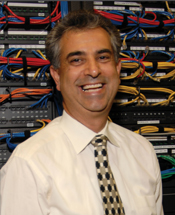 Dr. Rouzbeh Yassini, Ph.D.
Dr. Rouzbeh Yassini, Ph.D.
Is a serial entrepreneur, innovator, philanthropist and is the Executive Director of the University Of New Hampshire Broadband Center Of Excellence (https://www.unh.edu/broadband/), an interdisciplinary initiative devoted to the advancement of broadband Internet technology and services. Dr. Yassini is widely known as the “father of the cable modem,” reflecting his pioneering work in cable broadband technology as the founder and CEO of LANcity and as prominent contributor to the CableLabs Data-Over-Cable Service Interface Specifications (DOCSIS®), a pillar of today’s worldwide, multi-billion dollar broadband industry.
1987
Former GE executive Rouzbeh Yassini launches LANcity to explore data delivery over cableTV networks
1995
LANcity deploys its third-generation modem for less than $500, spurring rising industry interest
1996
Attracted by a growing market for cable modem technology, Bay Networks acquires LANcity
1997
CableLabs, based on contributions from Yassini, releases the first DOCSIS interoperability specification
1998
CED Magazine names Yassini “Man of the Year” for sparking the cable broadband revolution
2001
DOCSIS 2.0 is released, enhancing upstream data rate capabilities
2003
Yassini publishes Planet Broadband, a manifesto for the new connected age
2013
Yassini establishes the Broadband Center of Excellence at the University of New Hampshire
2014
U.S. cable companies combine for 51 million broadband subscribers
2017
Full-duplex DOCSIS renders support for fully symmetrical gigabit speeds
—
Credit: Shutterstock

